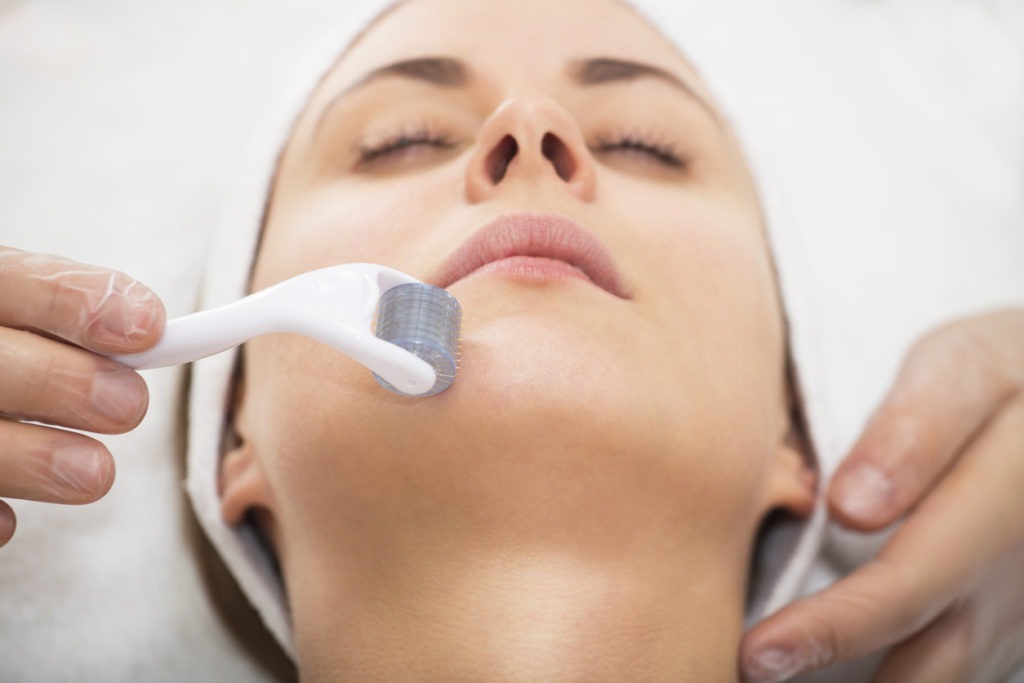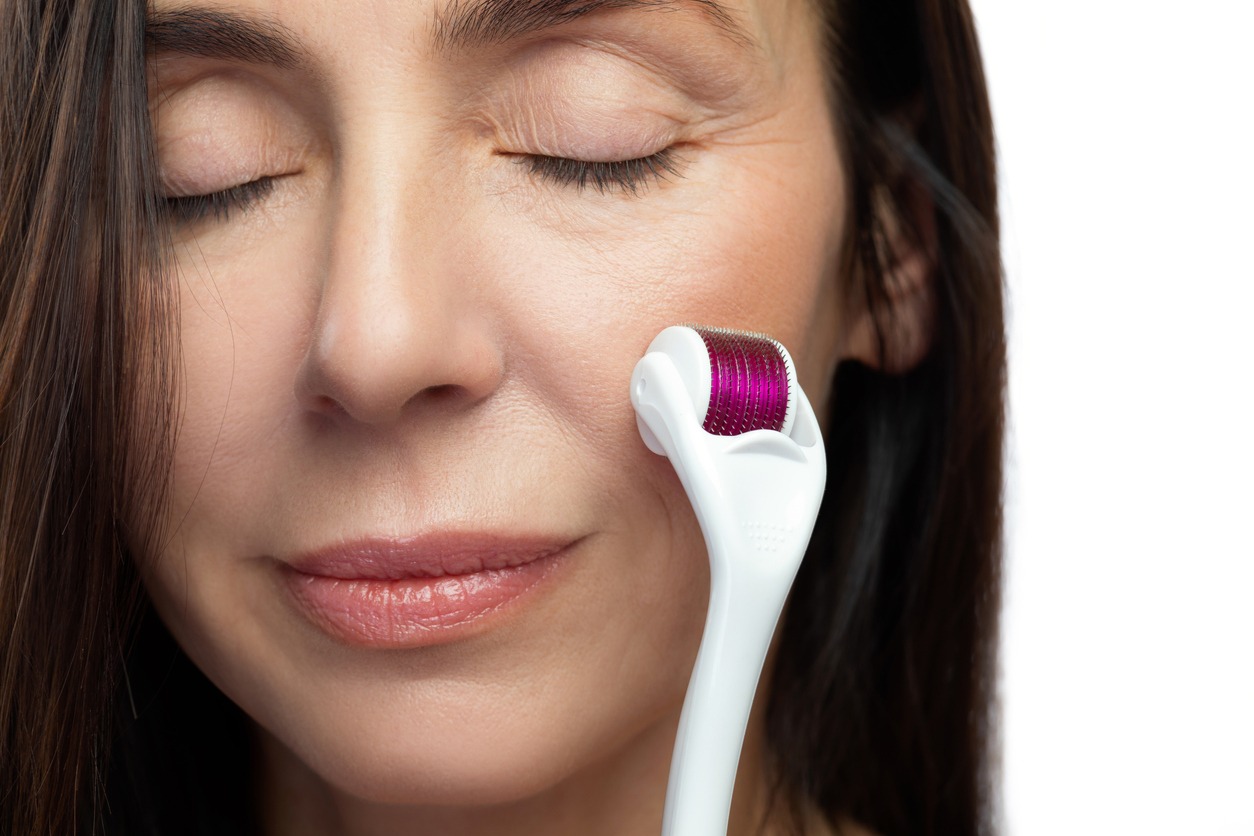The old phrase “beauty is pain” may be commonplace for anyone trying out the latest industry innovations. But it’s difficult to ignore the extreme risks that emerge when unregulated beauty tools, including microneedling, fall into the wrong hands.
The procedure, also known as dermarolling, entails moving a derma roller equipped with needles across the face. The goal is to activate our body’s wound-healing response, stimulating the production of hyaluronic acid and new collagen. The procedure can remodel scar tissue and reduce wrinkles and fine lines by creating new collagen to seal the microscopic wound, restoring the collagen that is damaged during acne or lost with the aging process.
The popularity of microneedling shows no signs of abating. With skincare show-and-tell becoming the norm, social media has fueled the rise in popularity, as influencers and celebrities tout microneedling as the trick to their glowing complexions.
So, how safe are derma rollers to use? Continue reading to find out.
How Safe Are Derma Rollers?
Microneedling is thought to be safe. However, as with many treatments, there are risks.
You may acquire an allergic reaction to the serum or cream applied to your skin following microneedling. And if you don’t keep the skin clean, the wounds may become infected. You should avoid places where there could be a lot of germs, such as swimming pools, rivers, lakes, and oceans, and avoid using irritating lotions and soaps.
Home rollers have shorter, duller needles compared to professional microneedling devices. They stimulate blood vessels temporarily to brighten the skin. However, derma rollers rarely produce the same results as microneedling performed at a medical spa or dermatologist’s office.
As with professional microneedling devices, Derma rollers can spread germs if not properly cleaned. On infected skin, do not use a home roller.
The Dangers of Using Derma Rollers
Using needles to regenerate skin may sound terrifying (as evidenced by the internet’s hundreds of gruesome yet intriguing images). Still, it is low-risk and virtually pain-free when done by a professional with a topical anesthetic.
It’s no surprise that the treatment’s growing popularity has resulted in an exponential rise in DIY devices, which are marketed for reducing scarring and fine lines, improving skin elasticity, smoothing the skin’s surface, and evening out skin tone. However, unlike getting a manicure at home or putting lemon juice in the hair, perforating the skin with lots of tiny needles can cause permanent damage if done improperly.
Although there are benefits to derma rolling, at-home microneedling is so dangerous because clinical (dermal-needling) and cosmetic (epidermal-needling) treatments are so dissimilar. An at-home device’s needle depth ranges between 0.1mm and 0.3mm and is primarily intended to improve skincare ingredient absorption.
Professional treatments increase the depth to 0.5mm-1.5mm in an aesthetician’s clinic and even deeper (up to 3mm) in a dermatologist’s clinic. The goal is to create a wound to trigger regeneration.
Worryingly, these professional-depth rollers are now widely available online for purchase and use at home by anyone. To access them and perform the treatment, you had to have either a medical experience or be an aesthetician trained in microneedling. It was only in recent years that the general public could purchase professional rollers online.
The incorrect technique can cause major micro-tears in the skin, leading to hyperpigmentation and scarring.
Professional microneedling treatment options start at £200 (approximately $245) per session, but an online search yields thousands of professional-depth rollers for a fraction of the price, some as low as $9. These unregulated tools, frequently low-quality imports with little information about proper usage or the manufacturer, are awash in online marketplaces.
Individual needles can also be dangerous if not made of reputable materials like surgical steel or titanium. This turns up the risk of bent needles, which can cause severe skin damage while invisible to the human eye.
The first risks occur when people use at-home skincare products that aren’t designed to be used on wounded — and thus compromised — skin. Topical skincare is intended for use on the skin’s surface and may contain silicones, fragrances, essential oils, and preservatives that our skin would normally filter out. However, when applied post-needling, they travel inside the skin, potentially triggering an immune response that can result in allergic reactions, skin sensitivity, and rashes.
When using unregulated devices in an unsanitary or clinical environment, the risk of infection is very high; it is also very easy to unwittingly derma roll a part of your face that is already infected. Although alcohol disinfects the derma roller, it is difficult to sterilize it completely, so not all harmful pathogens are killed. When needles are reused, they become blunt, which severely jeopardizes technique.
Micro-needling can be an excellent treatment for stretch marks, wrinkles, hyperpigmentation, scarring, and skin texture issues – but it is not without risks, particularly when performed at home. When performed by a skilled technician, it effectively addresses wrinkles and elasticity like nothing else.
Dermatologists generally advise against using the tools at home because the needles aren’t the correct size to properly penetrate the skin, causing you to harm your face for no reason. Derma rollers can harbor harmful bacteria that can cause breakouts and infections and trigger skin conditions like itchy inflammation spots, eczema, melasma, and rosacea, which causes bumps and redness on the face.
To Ensure a Safe Derma Rolling Experience
According to experts, look for a tool with needles aligned and evenly spaced. The needle placement is what distinguishes a bad tool from a good tool.
Before you begin an at-home derma rolling practice, you should be aware of the following:
- Before beginning a new skincare regimen, especially as drastic as microneedling, consult with your dermatologist or doctor.
- After every use, disinfect your derma roller with alcohol.
- Don’t use too much pressure—apply it gently and stop if it starts hurting.
- After microneedling, apply penetrative skincare products such as treatment oils, serums, and creams.
- Ensure the needles aren’t too long (no more than 0.25 mm in depth).
- Replace your needles as needed—if they become dull, it will be less effective.
- Introduce derma rolling as an at-home skincare boost a few times per week, gradually increasing to every other night.




